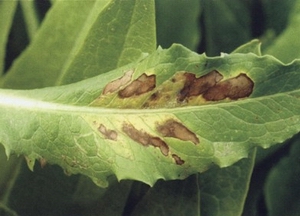 ional Bremia Evaluation Board (IBEB) has evaluated all Bremia races found in 2012 and races found earlier. In 2012, once again most outbreaks of Bremia were caused by new Bremia races with only local importance. However IBEB was able to identify and nominate three new races: Bl:29, 30 and 31. The Board emphasizes the importance of chemical control and hygiene measures in addition to the use of resistant varieties to prevent the development of new races.
ional Bremia Evaluation Board (IBEB) has evaluated all Bremia races found in 2012 and races found earlier. In 2012, once again most outbreaks of Bremia were caused by new Bremia races with only local importance. However IBEB was able to identify and nominate three new races: Bl:29, 30 and 31. The Board emphasizes the importance of chemical control and hygiene measures in addition to the use of resistant varieties to prevent the development of new races.Bremia lactucae, or downy mildew in lettuce, is genetically very variable. Even within one lettuce production field and within one isolate from a field, several races may be present. On November 30, 2012, the International Bremia Evaluation Board met in Paris to evaluate the Bremia lactucae races found in Europe in 2012. A total of 202 isolates were on the gross list of the companies and were discussed. About 42 isolates (21%) were lacking the ability to break important resistance genes used in common lettuce varieties. About 44 isolates (22%) of all 202 concerned previously described and officially nominated Bl: races, mostly Bl:22, Bl:24, Bl:25 and Bl:26 or closely related races (“Bl:” is the official code for races of Bremia lactucae).
As usual, most of the isolates encountered in 2012 were of minor importance because they disappeared quickly. Only three of the newly found and evaluated races since 2011 were important enough to be nominated as Bl:29, Bl:30 and Bl:31.
• Bl:29 appeared regularly in Portugal, North Spain, West France, The Netherlands, Ireland, United Kingdom and Belgium. The identifying sextet-code of Bl:29 is 59-63-47-03.
• Bl:30 has been regularly found in the previous years in UK, Benelux, Austria, Spain, France and Germany. It is already informally known as the Lancaster strain. The identifying sextet-code of Bl:30 is 59-63-13-03.
• Bl:31 appeared in France, Belgium, Switzerland, Austria, Hungary and Germany. The identifying sextet-code of Bl:31 is 63-63-12-06.
The board realizes that nominating 3 new races at the same time is quite a different approach from the past where usually one race was nominated per year. However as a result of the successful introduction of an increasingly wide range of resistance genes by breeding companies, a clear trend is visible where local isolates of Bremia appear which spread less fast than races nominated in the past. The three newly nominated races are not evenly spread over Europe and do not cause problems everywhere.
The board emphasizes that although breeding companies supply growers with lettuce varieties possessing resistance to the nominated Bl:1-31 isolates, this is not a full insurance against Bremia. The resistance gives the grower a basic protection. However, occasionally problems may be caused by a local breakthrough of resistance of specific varieties by an isolate that does not survive over years and does not spread to other areas.
The board emphasizes also the importance of chemical control and hygiene measures in addition to plant resistance. Fungicide application, especially in a young plant stage, gives additional protection to resistant lettuce crops, which will help prevent the development of new Bremia races. Proper hygiene practices, such as removal of debris and diseased plants and cleaning shoes after field visits, will reduce the spread of Bremia in lettuce crops.
The IBEB consists of representatives of the Dutch and French seed business associations Plantum and UFS, and the organisations of GEVES and Naktuinbouw. IBEB is supported by several Bremia investigators across Europe. The business associations were represented by lettuce breeders of Agrisemen, Enza Zaden, Gautier, Nunhems, Rijk Zwaan, Monsanto Seminis, Syngenta and Vilmorin.
For testing and breeding purposes all nominated races and EU-B determination set are available at GEVES/SNES (France) and at Naktuinbouw (The Netherlands).







